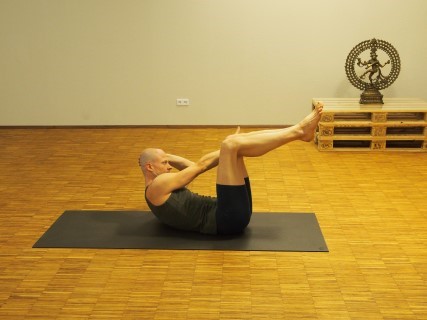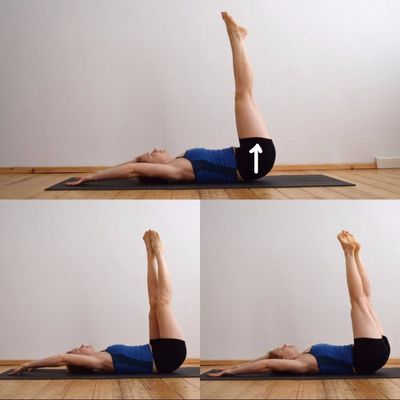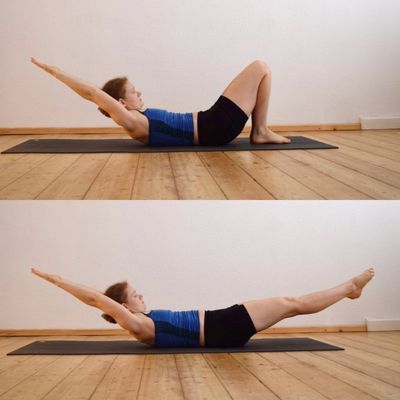CAVE: One variation other then shown above is to put the palms of your hands between your shouder blades. The head rests on both forearms
CAVE: One variation other then shown above is to put the palms of your hands between your shouder blades. The head rests on the left forearm.
Crunches
Come with your back to the floor. Lift your legs of off the floor your knees 90 degrees over your hips. Place your hands far behind your head ideally between your shoulder blades.
On the inhale roll yoursef up beginnig with the head until your shoulder blades loos contact to the floor.
Inhaling rotate to the left and slide your right hand diagonally to the outside of your left thigh.
Exhaling rotate back and bring your hand back between your shoulder blades. With a calm breathing rhythm change from side to side. If possible, make sure while executing this excersise your shoulder blades stay off the floor at all times.
Repeat until you are able to feel your lateral oblique abdominal muscles.
Effect
M. Obliquus Abdominis internus and externus, are by far more important for back health as the straight abdominal muscles. Through this motion you are able to effectivly target this muscle group.
In rotation the outer oblique abdominal muscle activates on the turned away side, the inner oblique abdominal muscle activates on the turned side. By changing sides, the tension of the layers changes also. This way the the interplay of both muscle groupes improves; this is also true for the layers here in motion.
Press Crunches
Lege Dich rücklings auf den Boden. Bringe Deine Knie 90 Grad gebeugt über Deine Hüften.
Belasse Deine Schulterblätter und Kopf fest auf dem Boden. Drücke jedoch mit beiden Händen fest gegen die Oberschenkel in der Nähe der Knie. Achte dabei darauf, dass die Wirbelsäule in ihrer neutralen S-förmigen Schwingung bleibt und die Ellenbogen gestreckt.
Halte die Spannung für einige ruhige Atemzüge bevor Du auf die andere Seite wechselst.
Effekt
M. Obliquus Abdominis internus und externus, die seitlichen schrägen Bauchmuskeln, sind für einen gesunden Rücken weit wichtiger als die geraden Bauchmuskeln. Durch den Druck entsteht automatisch Länge in der Wirbelsäule.
Pelvis Lifts
Once your oblique abdominal muscles have been worked form the exercise before, drop your shoulders down and straighten your arms over head onto the floor. Now lift your straight legs up vertically.
Inhaling lift your hip slightly of the floor. Make sure your feet remain right over your pelvis. Each time your legs move closer towards the head the work in the deep abdomen is compromised.
In the beginning it's enough to lift the pelvis a few millimeters off the floor for a second to challenge the deep belly muscles. With little practice these muscles quickly become stronger and you'll be able to float your pelvis over the floor and rotate the pelvis side to side around the axis of the legs.
Effect
This exercise leads to a strengthening of the deepest abdominal muscles.
Canoe
This exercise is by far the most difficult one in this series. Therefore, it is suitable only for Yogis with already fairly strong abdominal muscles.
Lay down flat on your back. Bring your straightened arms over head onto the floor. Bring the soles of your feet onto your mat as close as possible to your pelvis.
Now press your lumbar spine against your mat neutralizing it't natural curve. To do this roll yourself up beginning from your hands and upper body until your loose contact to the floor. In this stage this exercise is already a challenge for your deep abdominal muscles. Make sure your lumbar spine stays anchored to the floor.
To take it further straighten one leg hovering it just ab bit over the floor. In case your lumbar spine is still fixed onto the ground go ahead and straighten the other leg as well. As soon as the lumbar spine looses contact to the ground the exercise is over and give it a new try.
Effect
The most demanding exercise in this series to create and promote stability at the core of your body. This isn't just important for a healthy back yet enables you to develop the necessary stability for sophisticated arm balances.





